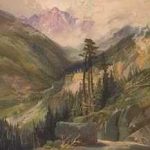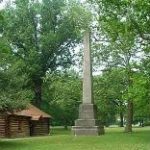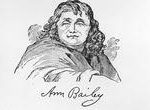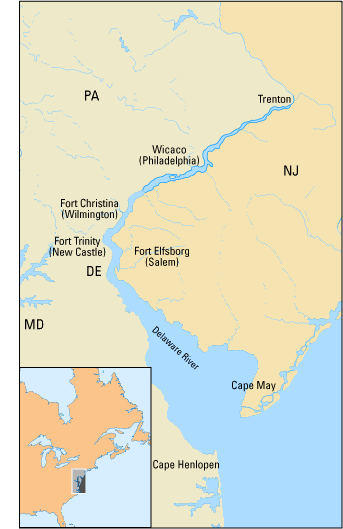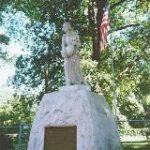Heroine of Fort Muncy
During the Revolutionary War, settlements throughout the Susquehanna Valley in north central Pennsylvania were attacked by Loyalists (Americans loyal to England) and Native Americans allied with the British. In the early summer of 1778, news came of a group of Native American warriors, perhaps accompanied by Loyalist and British soldiers, heading for the West Branch of the Susquehanna River to destroy settlements there.
There were many smaller incidents of violence against settlers in the area, but on June 10,1778, a party of sixteen settlers were attacked in what became known as the Plum Tree Massacre. Twelve of the sixteen were killed and scalped, including two women and six children. This news caused the local authorities to order the evacuation of the whole West Branch Valley.
General George Washington was unable to spare any of his troops to protect the people of the Valley, but sent Captain John Brady home to organize a group of volunteers in the Muncy area. For days, Captain Brady watched settlers from the north take boats down river to the protection offered by Fort Augusta at Sunbury.
Everything that could float was commandeered into service as hastily constructed rafts. Women and children rode on the rafts, while the men walked on the river bank to protect them and to drive along the livestock they had been able to save. Their abandoned property was burnt by the attackers.
In late July, help finally came when Captain Andrew Walker arrived with a squad of soldiers and orders to build Fort Muncy. As work on the fort progressed, soldiers were deployed to protect the settlers who were busily harvesting crops.
The Big Runaway
On August 8, 1778, a band of Indians attacked a group of settlers and Continental soldiers who were protecting farmer Peter Smith while he reaped his rye fields. During the attack, they killed several men and mortally wounded Captain Brady’s son. By that afternoon, a survivor reached Fort Muncy with the news of the massacre. As a small group of settlers gathered around the Fort, Captain Brady asked for a volunteer to ride up Muncy Creek to warn the settlers who were next to be attacked. Offering his own white mare for the journey, the Captain could still not find a person to warn the settlers.
From the back of the group, a young woman named Rachel Silverthorn volunteered (when no man would) to leave the relative safety of Fort Muncy to warn all the settlers who were in danger. Before anyone could react, Rachel mounted the Captain’s horse, and was riding toward the nearest cabin on the creek.
Rachel returned later that night, and under the cover of darkness, every exposed settler was safely housed in the fort. When morning dawned, the fires from burning cabins could be seen on the horizon. Her own family’s cabin was burned to the ground. Some settlers reported fleeing at night with the glow of their burning settlements lighting the sky behind them.
This came to be known as the Big Runaway, when settlers fled from their homes with barely the clothes on their backs. Four-fifths of the population of the West Branch Valley deserted their homes. The loss in property and goods was estimated at 40,000 pounds (approximately $200,000).
As soon as the enemy had retired from the valley, the settlers began to return to their homes. In their haste, it had been impossible to corral all their livestock, and some of the braver men hurried back to salvage what they could. The Silverthorn family returned and erected a temporary shelter on the charred remains of their log cabin, and made an effort to harvest their ripening grain fields. As soon as a large number of settlers had returned, the guerrilla warfare was resumed. Small bands of Indians were continually prowling through the territory annoying the settlers as they tried to rebuild their homes.
The Hartley Expedition
The State authorities, by this time aware of the necessity of protecting the frontier, ordered Colonel Daniel Brodhead, with a company of 125 men, to the region. The presence of the soldiers restored confidence among the people. Under their protection, the harvest that had escaped the torch of the Indians was gathered. Colonel Brodhead remained until August 1, when he was replaced by Colonel Thomas Hartley, who was deeply moved by the poverty-stricken plight of the inhabitants. One of his first duties was to build Fort Muncy, demanded by the women of the frontier before they would return.
The authorities, believing that the most effective means of ending the raids was to invade their territory, directed Colonel Hartley to lead an expedition against the Indians. On September 24, 1778, Colonel Thomas Hartley led a force of about 200 men up the Lycoming Creek to the North Branch of the Susquehanna to strike back against the Native Americans.
The first engagement occurred on Lycoming Creek, where an Indian chief was killed and his followers routed. At an Indian town near the present town of Ulster, a second victory was won. From this place Hartley and his men moved on to Teago, destroyed the village, took prisoners, and captured livestock and other articles of value.
Hartley’s expedition covered about 300 miles in two weeks, defeated several bands of Native Americans, and destroyed a few native villages. Hi’s losses were four men killed and ten wounded. Aside from the number of Indians killed and captured, he returned to Fort Augusta with fifty head of cattle, twenty-eight cannons, and other useful plunder. He had destroyed Queen Esther’s town, and for a time at least had subdued the Indians.
From the prisoners captured by the expedition, it was learned that preparations were being made for other attacks along the West Branch. Although Hartley’s expedition did not end the trouble with the Indians, it did effect the postponement of a general attack. The expedition received a vote of thanks from the Supreme Executive Council for its splendid work.
Death of Captain John Brady
Smarting from their defeat by Colonel Hartley, the Indians waited for an opportunity to avenge their losses. Captain John Brady, who had been released from service in the Continental Army to assist Hartley in the expedition, proved so valuable that he received special mention in Hartley’s report. Because of his capability as a frontier lighter, Brady was hated and feared by the Indians. During the fall and winter of 1778-1779, the situation near Muncy, where Brady lived, was comparatively quiet. Brady’s family lived near the mouth of Glade Run in a stockaded house, known at the time as Brady’s Fort.
Accompanied by several men, Brady one day traveled to Fort Muncy for supplies. Having obtained them they started to return to his house. Brady, riding a horse, had lingered in the rear. Peter Smith, who had lost his wife and children in the massacre of June 10, 1778, was walking beside his mount talking with him. When the pair were within a short distance of his home, Smith proposed they take a short cut, which they did. As they approached Wolf Run, three rifles cracked and Brady fell from his horse, dead. Brady’s body was buried in a small cemetery on a knoll facing the Susquehanna River near Hall’s Station. The funeral was attended by nearly everyone in the settlement.
The Little Runaway
Brady’s death was a serious blow to the settlers, because the Indians resumed the attacks with increased vigor. Meanwhile, General John Sullivan was making preparations for an expedition on the North Branch of the Susquehanna. His purpose was to drive the Indians from the vicinity and, if possible, from the entire northern part of the state.
Sullivan’s base of supply was Fort Augusta at Sunbury. Supplies were transported up the river in boats, as many as 200 being used at one time. Sullivan believed that as his army moved up the North Branch the Indians would be drawn to that section to resist him, and thus the West Branch Valley would be in no great danger.
But Sullivan’s strategy was faulty. The Indians, already acquainted with his plan, had mapped theirs accordingly. They planned to drive through the West Branch Valley and attack Sullivan from the rear. With a strong force in front of his party and another attacking from the rear, they believed Sullivan could easily be defeated.
Rumors of the approach of a large force of Indians reached the settlements every day. Colonel Hepburn, in charge at Fort Muncy, decided to send a scout up Lycoming Creek to ascertain the truth of these rumors. Robert Covenhoven, who preferred to go alone. In the dense forest he discovered a large force of Indians. After concealing himself in a heavy thicket and observing them for a day, Covenhoven concluded they were preparing to swoop down the West Branch again. He immediately returned to Fort Muncy and reported his findings to Hepburn.
Covenhoven’s observation proved to be correct, The marauding Indian bands who had been harassing the settlements were only the advance guards of the vast hordes concentrating in the wilderness along Lycoming Creek. Hepburn at once notified the inhabitants of the threatening danger and they made immediate preparations to evacuate the territory.
Although there was less excitement and confusion than at the time of the Big Runaway, the settlers retreated to Fort Augusta in much the same manner. The women, children, and household goods went down the river in rafts, boats, and canoes. The men, under the leadership of Robert Covenhoven, marched along the bank as guards.
The enemy entered the valley on July 26, 1779, with approximately one hundred Tories and British and two hundred Indians. The British and Tories were commanded by Captain John McDonald from Albany, New York; the Indians were led by Hickatoo, a Seneca chief. They came down Lycoming Creek to the river valley, and followed the West Branch. Settlers who either had ignored, or had not received the warning, were attacked and more than half their number killed. The women and children were made prisoners, and the fort was burned.
McDonald and his allies were enraged to discover that most of the inhabitants had escaped. They scoured the countryside, burning every cabin, granary, and haystack. Fort Muncy was destroyed. The livestock was driven away for their own use. By this time, Sullivan’s army was well on its way up the North Branch.
Messengers were sent to McDonald and Chief Hickatoo to hurry back northward to resist Sullivan’s advance. They arrived in time to take part in the Battle of Newton, where the British and Indians were badly defeated. The Little Runaway aroused the state authorities to provide adequate military protection for white settlers on the frontier.
General Sullivan’s expedition gave the Indians a taste of war in their own territory. Although roving bands still raided the settlements, and scalpings were frequent, Sullivan had dealt the enemy a blow from which they did not recover. These attacks on the Pennsylvania frontier led to retaliatory scorched earth tactics by the American army against Native Americans, which destroyed more than forty Iroquois villages.
SOURCES
Fair Play Men
The Big Runaway
History of Lycoming County Pennsylvania

